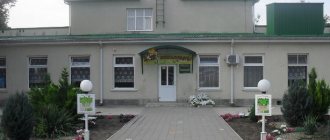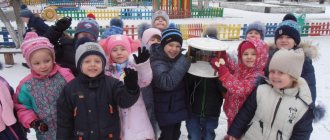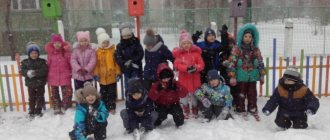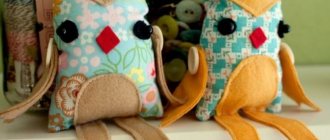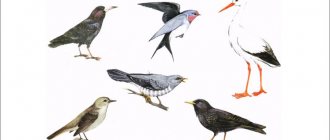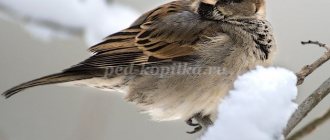Social environmental project “Feed the birds in winter!”
- May 5, 2021
International and All-Russian competitions
All-Russian conference “Young researcher: project activities of junior schoolchildren”
“To protect nature means to protect the Motherland” M.M. Prishvin
INTRODUCTION
Relevance and rationale for choosing the topic of project work .
Winter is a wonderful time of year. But, at the same time, winter means severe frosts, heavy snowfalls and piercing winds. Winter is a difficult time for all living things.
In our area, winter begins, as expected, in early November. Despite the unpredictability of the weather, many birds still remain in their native places for the winter. However, with the onset of cold weather, the feathered inhabitants of the forest flock closer to human habitation. The birds are waiting for help from us!
The frosts are severe this year... Worried about the apple tree in our garden, Worried about the Bug. In her kennel there is the same frost as in the yard. But most of all I worry about the birds, about our sparrows, jackdaws, tits: After all, it’s very cold for them in the air. Will we help these defenseless people?
E. Blaginina
A large number of birds die in winter.
- How to help birds in winter?
- What should you do to protect them in winter?
Problematic issues served in choosing the topic of the project.
Hypothesis : it can be assumed that cold is not as bad for birds as hunger.
Goal : organize help for birds in the winter.
Tasks:
Theoretical:
- Conduct a survey on the project topic.
- Study the diversity of wintering birds in our area.
- Learn the rules for making and placing feeders.
- Learn the rules for feeding birds and the composition of feed.
- Present the results obtained.
Practical:
- Monitor the species composition of birds arriving at feeders.
- Make and place feeders on the school grounds.
- Organize regular feeding of birds.
Promising:
- Make and place feeders around the house.
- Continue work on feeding birds in winter.
Practical significance.
Caring for our little brothers and helping them fosters compassion, mercy, forms moral qualities, evokes positive emotions, and also helps to develop attention, imagination, observation, patience, hard work, will, etc.
Work in this direction is not carried out with the aim of receiving awards, but is designed to find a response in the heart.
Subject areas: the environment, local history, ecology, literary reading, technology, fine arts, music, physical education.
Methods:
- Survey (questionnaire).
- Collection of information.
- Observation.
- Practical work.
- Analysis of results.
Stages of work:
- Preparatory (posing a problem, defining goals and objectives, planning work).
- The main one (work on implementing the plan, searching and selecting materials, making feeders, feeding birds, observation).
- Final (defense of the project, conclusions, summing up, reflection).
Project “Feed the birds in winter!”
MAIN PART
Preparatory stage.
It is important to provide all possible assistance to our feathered friends. Unfortunately, not everyone thinks about the living creatures that live next to us. I wanted to convey this information to my classmates and try to interest them in the problem of wintering birds in our village. The set tasks became a clarification of the project goal.
A survey of classmates was conducted to determine their existing knowledge:
- do they know what birds live in our area in the winter;
- do they know what wintering birds eat;
- do they know how to help birds in winter?
Main stage.
Using the recommendations of the Voronezh Nature Reserve, we compiled a guide on how to properly make a feeder and where it is best to place it.
What kind of hut-houses swayed above the ground? These are new feeders. You and I made them. We'll warm the birds, treat them, and won't let them die! And even if winter threatens, it’s not scary now!
E. Grudanov
Together with my classmates, we made a variety of feeders from various materials: from plastic bottles, juice boxes, milk, and there were also wooden feeders.
Our parents helped us hang the feeders. It was necessary to remember that it was impossible to nail feeders to trees. Otherwise, the tree may be damaged. Therefore, parents attached feeders to trees using wire and ropes. It was also necessary to take into account that the feeders should be placed in accessible places. It should be possible to replenish them with food.
With my dad's help, I made a wooden feeder. Dad took the board, processed it and sawed it into pieces. Then I fastened these parts with screws. The roof was made of plastic. Our feeder is ready! (Annex 1).
It is difficult for birds after heavy snowfalls. Can't find food under the snow. The time has come for serious testing!
Sometimes, after a thaw, frost sets in and the trees and bushes become covered with an ice crust, and here too the birds have a hard time. Neither the tenacious claws on their paws nor their sharp beak will help them: the ice has firmly bound the cracks and crevices in which the insects hide.
The winter day is short - there is very little time to gain strength!
The winter day is getting shorter and shorter. Before you have time to have lunch, the sun will set behind the fence. Not a mosquito, not a fly - Just snow and snow everywhere...
Yu. Sinitsyn
With the help of additional literature and observations, we found out which birds winter in our area. These are sparrows, tits, woodpeckers, nuthatches, magpies, crows and others.
We found out what wintering birds eat and compiled a memo “Poultry Canteen Menu”.
We made sure to leave treats at the feeders every day for our feathered friends.
Prospects for the future.
We hope to continue helping birds next year. I would like for helping our little brothers to become a good tradition in our class.
This is our custom; As soon as it snows, we’ll hang the plank birdhouse on a twig. No grains, no blades of grass - it’s hungry time. The needles of the ice floes are shining, the midges have disappeared. But here, in the garden, behind the school, among the gray branches, a cheerful lunch is ready for the children’s birds. Above the plank house in the morning there is a non-silent din, How joyful the winged, fluttering guests are! Everyone is happy to taste millet and bread crumbs. Our school garden is miles away from songs of praise. M. Pozharova
CONCLUSION
Observations helped to find out that sparrows and tits winter near human habitation; nuthatches and woodpeckers fly from the forest to feed.
We learned how to make feeders with the help of our parents. We learned what food you can and cannot feed birds.
After placing feeders on the school grounds and organizing regular feeding of birds, the number of birds visiting feeding areas increased.
We've found that colder weather attracts more feathered visitors to bird feeders, so it's important to remember to feed the birds. The colder it got, the more birds we had at our feeders. This means that the hypothesis was confirmed: “For birds, it is not the cold that is terrible, but hunger!”
With my work I would like to attract the attention of school students and village residents to the problem of wintering birds in our area. If we organize feeding, we will help the birds survive the cold period and maintain their numbers. After all, it is the birds that determine whether our gardens will turn green in the spring. Each of us is capable of helping our feathered friends in difficult times!
Feed the birds in winter. Let flocks of people flock to your porch from all over, as if it were home.
It’s hard to count how many of them are dying. It’s hard to see. But in our heart there is also warmth for the birds.
Teach the birds to your window in the cold, So that we don’t have to welcome spring without songs.
A. Yashin
BIBLIOGRAPHY _
- Birds. Complete encyclopedia/ Julia Shkolnik. – M.: Eksmo, 2006
- Encyclopedia for children. Birds and animals / ed. V. Volodin. –M.: Avanta, 2004
Project presentation
Project title: “Feed the birds in winter.”
author: Bobrova Anastasia Albertovna
Teacher of additional education in ecology, Inta city, Komi Republic MBDOU "CRR-kindergarten No. 31 "Krepysh"
Project title: “Feed the birds in winter.”
Project name
: “Feed the birds in winter.”
Author of the project
: Bobrova Anastasia Albertovna, teacher of additional education in ecology, MBDOU “CRR-kindergarten No. 31 “Krepysh”, Inta city, Komi Republic
Problem:
The cold is not as terrible for birds as hunger is. Birds die in winter. A hungry bird cannot withstand frost. If the bird is full of it and severe frost is not scary. Can we help them? How can we help the birds? Do we know what we can feed birds?
Project type
: information - practice - oriented.
Project focus:
socially significant activity.
Relevance of the topic:
This project is an important part of the environmental education of preschool children; through its implementation, moral standards of behavior are formed, aimed at bringing children closer to understanding the beauty of the world around them, the need to protect it, awaken in them the desire to be kind and attentive, and teach them to love nature. Thus, involving preschoolers in practical environmental activities helps to cultivate an environmental culture and a caring attitude towards nature.
Description of practical significance
:
- In the course of working on this project, children's knowledge about the birds of the Komi Republic, their way of life, their connection with the environment, and the role of humans in the life of birds is expanded;
- Children develop an active life position;
- Children learn to empathize and help our smaller brothers. Involving children in helping wintering birds is a powerful educational factor in the development of environmental consciousness.
- Involving parents in participating in project activities (making feeders, purchasing bird food) helps strengthen the child-adult community (teachers - children - parents.
Target :
- Help the wintering birds of the city of Inta survive the cold and harsh winter.
- Raise environmentalists, teach them to be merciful.
- Formation of ecological knowledge about wintering birds and a responsible, careful attitude towards them.
Tasks :
- Introduce birds that winter in our region; find out what they eat;
- Find out how we can help wintering birds;
- Find out what types of feeders there are; Make different types of feeders with your own hands and with the help of your parents.
- Make a note about what you can feed birds in winter;
- Draw posters as a reminder of the need to feed the birds in winter.
- Promote the development of cognitive activity and curiosity;
- To encourage students to acquire the experience of belonging, mercy, and sympathy for the misfortune of others;
- To promote children's awareness of the importance and necessity of their activities;
- Develop a caring, kind attitude towards birds, a desire to help in difficult winter conditions.
Project participants:
children of senior and preparatory groups and their parents.
Duration:
mid-term (3 months)
Expected results of the project:
- Creation of the necessary conditions for the formation in preschoolers of a holistic understanding of the life of wintering birds.
- The interest of children together with their parents in caring for birds, the desire to help them in the winter (making feeders, feeding birds in winter).
- Development of curiosity, creativity, cognitive activity, and communication skills in children.
- Active participation of parents in the implementation of the project.
- Formation in children and adults of a certain system of natural history knowledge that allows them to understand the unity of all nature and the place of man in it.
Novelty of the project:
- the acquired knowledge has a practical orientation, the result of which is: the inclusion of knowledge in various games, making a laptop, making different feeders, feeding birds with the right food;
- pupils have the opportunity to look at birds from different perspectives: the needs of birds, folk wisdom, scientific facts;
- interaction of children while working on a project in specially organized micro-groups, the composition of which is determined by their age.
Project implementation stages:
Stage I – preparatory
- Create conditions for the formation of increased knowledge about wintering birds.
- Draw up a plan for joint activities to care and feed birds in winter.
- Invite parents to participate in this project (food, feeders)
4. Selection of literature, pictures, encyclopedias about wintering birds.
- Appeal to kindergarten children (leaflets).
Stage II - main
Goal: developing ideas and knowledge about wintering birds and the skill of helping them in winter.
1.Conversations
- Conversation on the topic “Titmouse Day”
- “What do you know about birds?”
- “How our feathered friends live in winter”
- "Who Takes Care of the Birds"
- “Do birds bring benefit or harm?”
- "Birds Menu"
- “How do children and their parents take care of birds in winter?”
- Observations
- Observation of tit, crow, bullfinch, jackdaw, pigeon
- Observing which birds come to the feeders
- Installation of feeders, feeding, regular feeding of birds.
3.Labor
- making feeders (together with parents)
- cleaning feeders
- bird feeding
- Play activity
- Didactic games: “One-many”, “Odd Four”, “Guess the bird by description”, “Whose tail?”, “Who eats what”, “Find out by voice”, “What do birds eat”.
- Word games: “Say the opposite”, “Name it affectionately”, “Who gives what voice?”, “One-many”, “Big - small”, “Count the birds”, “Guess by the description”, “Whose is it?”
- Board games: “Dominoes” (birds), “Cut pictures”
- Outdoor games: “Birds in a cage”, “Geese and swans”, “Owl”, “Migration of birds”, “Birds in nests”, “Owl - owl”; "Birds and Cat"
- Phys. minutes “What is winter like for whom?”, “What has man learned from birds?”
- Information in the corner for parents
- "Feed the birds in winter"
- Memo “How to feed birds.”
- Rules of conduct near feeders.
6.Communication
- Reading stories: I. Turgenev “Sparrow”, M. Gorky “Sparrow”
- N. Rubtsova “Sparrow” and “Crow”
- E. Bulgakov “Titmouse”
- Sukhomlinsky “What does the titmouse cry about”
- View presentations: “Wintering birds”
- The story "Bird's Dining Room"
- Guessing riddles about wintering birds
- Looking at illustrations of wintering birds
- Artistic creativity
- Drawing “Titmouse”, “Birds on the branches”, “Merry and sad bird”
- Modeling from plasticine “Learning to sculpt birds”, “Bullfinches in the snow”
- Construction "Bird"
Stage III - final
- Exhibition of feeders “Dining room for birds”.
- Distribution of bird feeders on the territory of the kindergarten.
- Organization of children's duty at the poultry canteen.
- Participation of children and parents in the All-Russian Action “Feed the Birds in Winter” The organizer of the action is the Federal State Budgetary Institution “National Park “Yugyd Va”
- Participation in competitions of the Russian Bird Conservation Union
Project activity product:
- Lessons about wintering birds of our region;
- Making and hanging feeders made by parents of preschool children;
- Release of the brochure “What can you feed birds!”;
- Making posters “Feed the birds in winter” and hanging them in stores in our city;
- Visit to the local history museum on the topic “Wintering birds of the Komi Republic.
- Drawing pictures of posters with children of senior and preparatory groups on the topic “Wintering birds of Yugyd va;
- Making an “Edible feeder - cookies” by children of preparatory groups.
- Drawing up folk signs about birds.
Efficiency
During the implementation of the project, pupils and parents constantly took care of the birds, but the question arose: “who else can take care of birds in the winter?” And we began to involve residents of our city in feeding the birds and designed leaflets and posters “Feed the birds in winter!” and reminders “What to feed the birds?” and hung them in the shops of our city.
In this way, our students successfully develop a humane and value-based attitude towards nature and all living things. During the implementation of the project, the students not only expanded and systematized their ideas about bird species, but also in practical activities learned what kind of food birds prefer and what various feeders can be made with their own hands using different materials. During the duration of the project, the birds have become accustomed to receiving food, so feeding must be continued, and we will feed them until the insects appear.
Prospects for further development of the project
- Make helping birds in winter a good tradition
- Involving adults in the environmental campaign “Feed the Birds”
- Involving more children in the project next year.
